CHC52015 Diploma of Community Services: Case Management Assessment
VerifiedAdded on 2023/05/31
|63
|8971
|147
Homework Assignment
AI Summary
This assessment workbook focuses on case management principles within the CHC52015 Diploma of Community Services. It covers key areas such as understanding competency-based assessment, the principles of assessing nationally recognized training, and the dimensions of competency. The workbook includes instructions, assessment requirements, and methods, specifically knowledge assessments and case studies. It emphasizes reasonable adjustments for learners with disabilities and details the units of competency addressed, including CHCCSM005, CHCCCS004, and CHCCSM004. The assessment requires students to demonstrate their knowledge of case management processes, client interaction, and legislative requirements, with a focus on applying this knowledge in practical scenarios. Desklib provides access to this and other solved assignments.
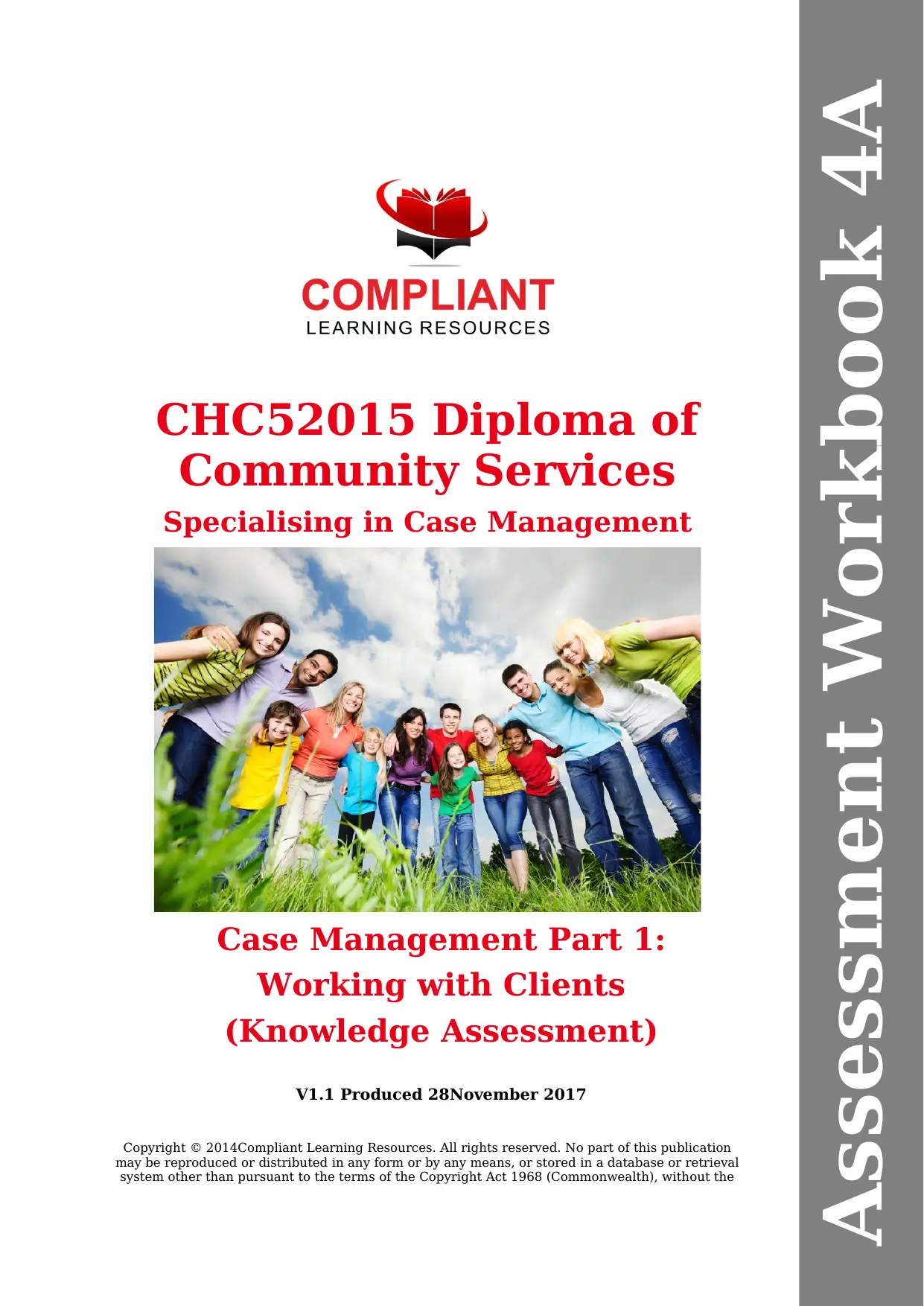
CHC52015 Diploma of
Community Services
Specialising in Case Management
Case Management Part 1:
Working with Clients
(Knowledge Assessment)
V1.1 Produced 28November 2017
Copyright © 2014Compliant Learning Resources. All rights reserved. No part of this publication
may be reproduced or distributed in any form or by any means, or stored in a database or retrieval
system other than pursuant to the terms of the Copyright Act 1968 (Commonwealth), without the
Assessment Workbook 4A
Community Services
Specialising in Case Management
Case Management Part 1:
Working with Clients
(Knowledge Assessment)
V1.1 Produced 28November 2017
Copyright © 2014Compliant Learning Resources. All rights reserved. No part of this publication
may be reproduced or distributed in any form or by any means, or stored in a database or retrieval
system other than pursuant to the terms of the Copyright Act 1968 (Commonwealth), without the
Assessment Workbook 4A
Paraphrase This Document
Need a fresh take? Get an instant paraphrase of this document with our AI Paraphraser
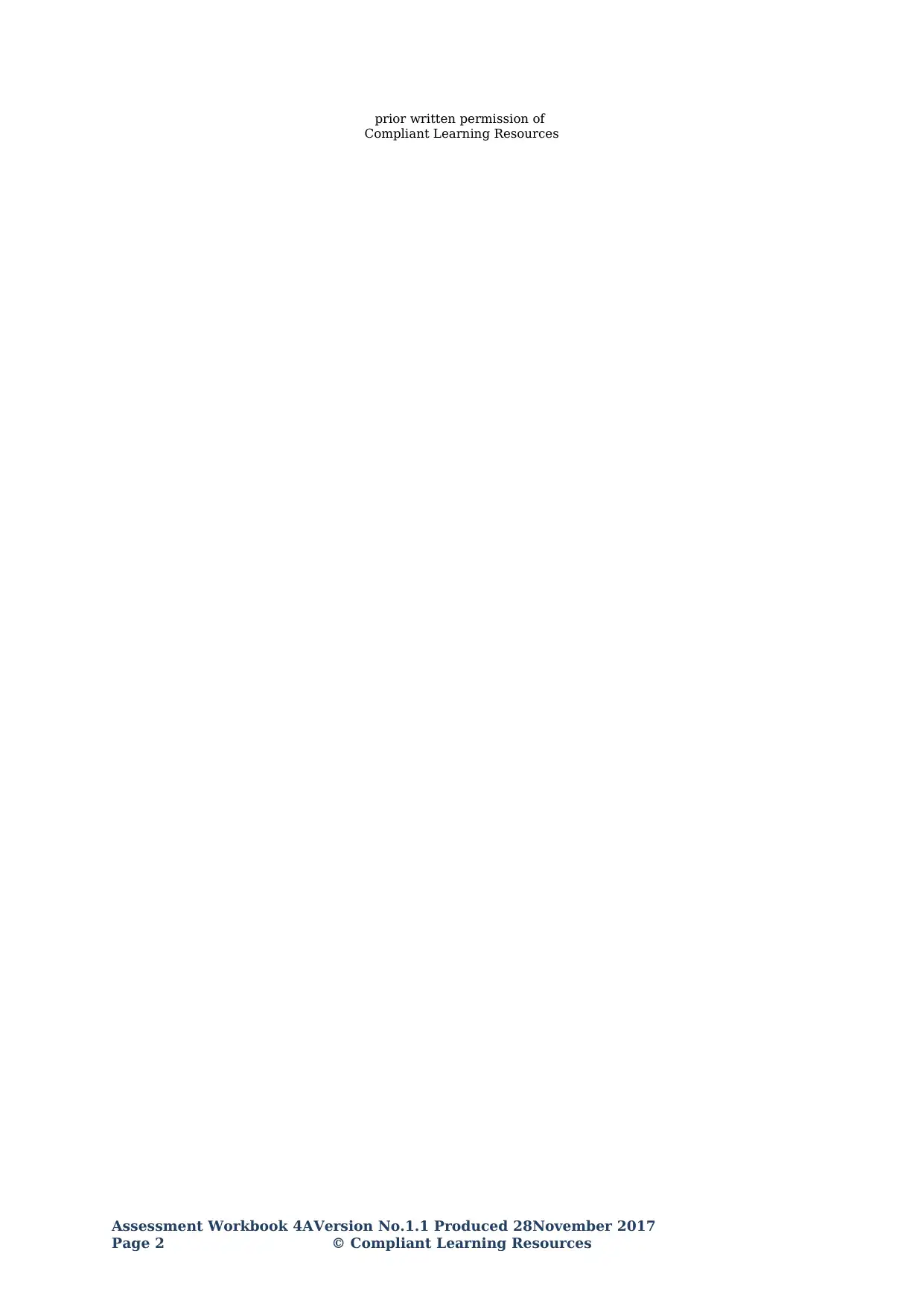
prior written permission of
Compliant Learning Resources
Assessment Workbook 4AVersion No.1.1 Produced 28November 2017
Page 2 © Compliant Learning Resources
Compliant Learning Resources
Assessment Workbook 4AVersion No.1.1 Produced 28November 2017
Page 2 © Compliant Learning Resources
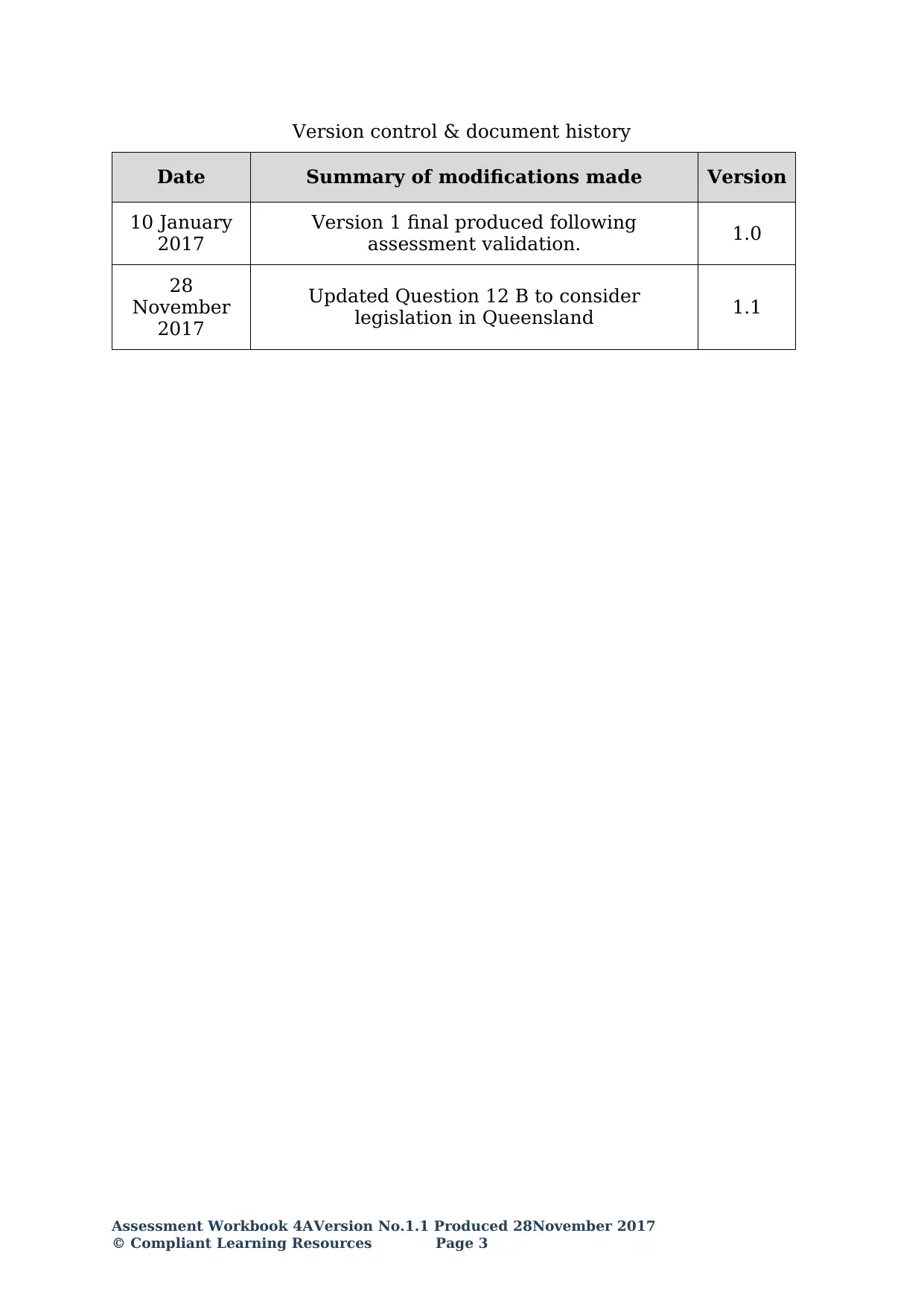
Version control & document history
Date Summary of modifications made Version
10 January
2017
Version 1 final produced following
assessment validation. 1.0
28
November
2017
Updated Question 12 B to consider
legislation in Queensland 1.1
Assessment Workbook 4AVersion No.1.1 Produced 28November 2017
© Compliant Learning Resources Page 3
Date Summary of modifications made Version
10 January
2017
Version 1 final produced following
assessment validation. 1.0
28
November
2017
Updated Question 12 B to consider
legislation in Queensland 1.1
Assessment Workbook 4AVersion No.1.1 Produced 28November 2017
© Compliant Learning Resources Page 3
⊘ This is a preview!⊘
Do you want full access?
Subscribe today to unlock all pages.

Trusted by 1+ million students worldwide
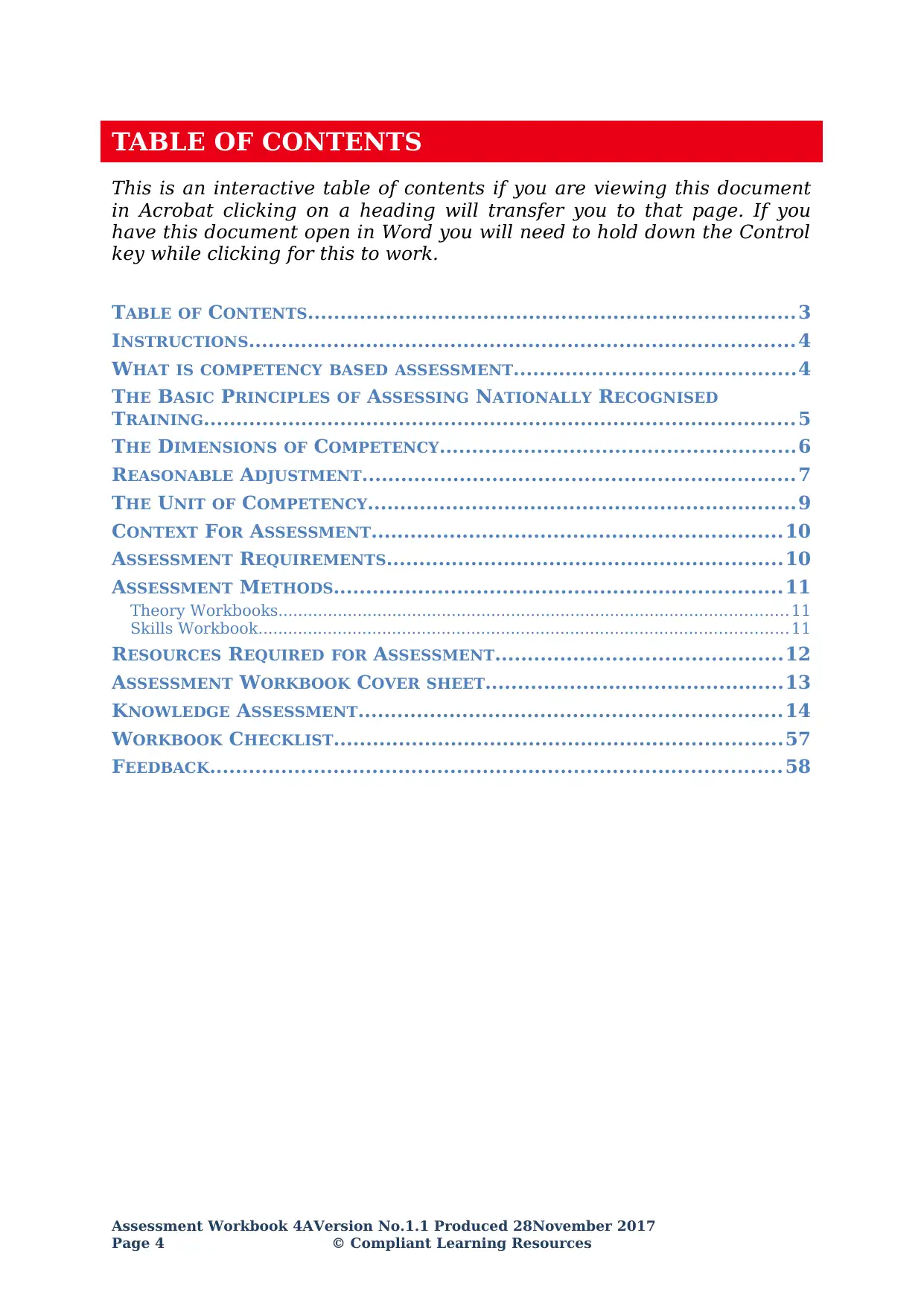
TABLE OF CONTENTS
This is an interactive table of contents if you are viewing this document
in Acrobat clicking on a heading will transfer you to that page. If you
have this document open in Word you will need to hold down the Control
key while clicking for this to work.
TABLE OF CONTENTS...........................................................................3
INSTRUCTIONS....................................................................................4
WHAT IS COMPETENCY BASED ASSESSMENT...........................................4
THE BASIC PRINCIPLES OF ASSESSING NATIONALLY RECOGNISED
TRAINING........................................................................................... 5
THE DIMENSIONS OF COMPETENCY.......................................................6
REASONABLE ADJUSTMENT..................................................................7
THE UNIT OF COMPETENCY..................................................................9
CONTEXT FOR ASSESSMENT...............................................................10
ASSESSMENT REQUIREMENTS.............................................................10
ASSESSMENT METHODS.....................................................................11
Theory Workbooks....................................................................................................... 11
Skills Workbook........................................................................................................... 11
RESOURCES REQUIRED FOR ASSESSMENT............................................12
ASSESSMENT WORKBOOK COVER SHEET..............................................13
KNOWLEDGE ASSESSMENT.................................................................14
WORKBOOK CHECKLIST.....................................................................57
FEEDBACK........................................................................................ 58
Assessment Workbook 4AVersion No.1.1 Produced 28November 2017
Page 4 © Compliant Learning Resources
This is an interactive table of contents if you are viewing this document
in Acrobat clicking on a heading will transfer you to that page. If you
have this document open in Word you will need to hold down the Control
key while clicking for this to work.
TABLE OF CONTENTS...........................................................................3
INSTRUCTIONS....................................................................................4
WHAT IS COMPETENCY BASED ASSESSMENT...........................................4
THE BASIC PRINCIPLES OF ASSESSING NATIONALLY RECOGNISED
TRAINING........................................................................................... 5
THE DIMENSIONS OF COMPETENCY.......................................................6
REASONABLE ADJUSTMENT..................................................................7
THE UNIT OF COMPETENCY..................................................................9
CONTEXT FOR ASSESSMENT...............................................................10
ASSESSMENT REQUIREMENTS.............................................................10
ASSESSMENT METHODS.....................................................................11
Theory Workbooks....................................................................................................... 11
Skills Workbook........................................................................................................... 11
RESOURCES REQUIRED FOR ASSESSMENT............................................12
ASSESSMENT WORKBOOK COVER SHEET..............................................13
KNOWLEDGE ASSESSMENT.................................................................14
WORKBOOK CHECKLIST.....................................................................57
FEEDBACK........................................................................................ 58
Assessment Workbook 4AVersion No.1.1 Produced 28November 2017
Page 4 © Compliant Learning Resources
Paraphrase This Document
Need a fresh take? Get an instant paraphrase of this document with our AI Paraphraser
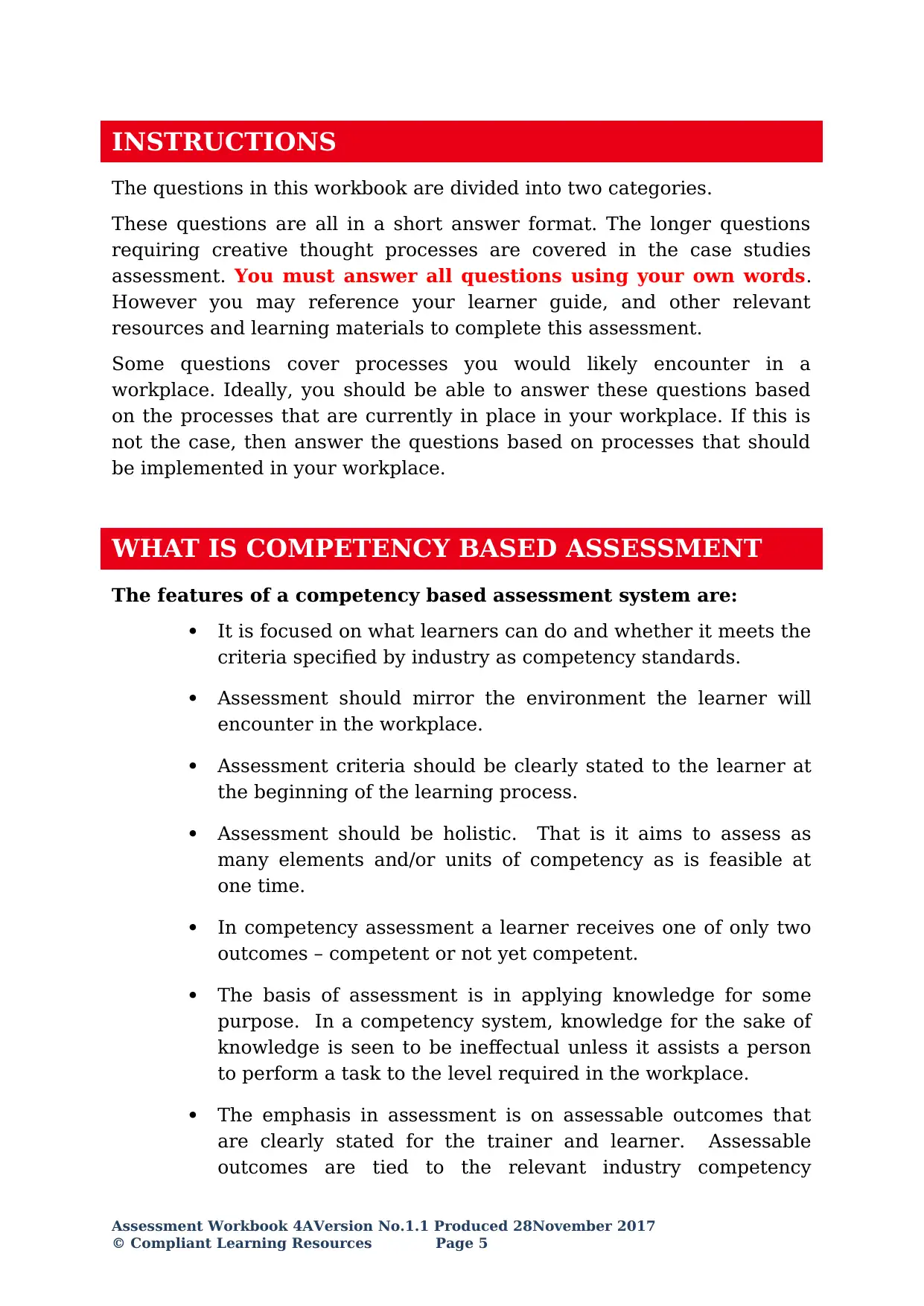
INSTRUCTIONS
The questions in this workbook are divided into two categories.
These questions are all in a short answer format. The longer questions
requiring creative thought processes are covered in the case studies
assessment. You must answer all questions using your own words.
However you may reference your learner guide, and other relevant
resources and learning materials to complete this assessment.
Some questions cover processes you would likely encounter in a
workplace. Ideally, you should be able to answer these questions based
on the processes that are currently in place in your workplace. If this is
not the case, then answer the questions based on processes that should
be implemented in your workplace.
WHAT IS COMPETENCY BASED ASSESSMENT
The features of a competency based assessment system are:
It is focused on what learners can do and whether it meets the
criteria specified by industry as competency standards.
Assessment should mirror the environment the learner will
encounter in the workplace.
Assessment criteria should be clearly stated to the learner at
the beginning of the learning process.
Assessment should be holistic. That is it aims to assess as
many elements and/or units of competency as is feasible at
one time.
In competency assessment a learner receives one of only two
outcomes – competent or not yet competent.
The basis of assessment is in applying knowledge for some
purpose. In a competency system, knowledge for the sake of
knowledge is seen to be ineffectual unless it assists a person
to perform a task to the level required in the workplace.
The emphasis in assessment is on assessable outcomes that
are clearly stated for the trainer and learner. Assessable
outcomes are tied to the relevant industry competency
Assessment Workbook 4AVersion No.1.1 Produced 28November 2017
© Compliant Learning Resources Page 5
The questions in this workbook are divided into two categories.
These questions are all in a short answer format. The longer questions
requiring creative thought processes are covered in the case studies
assessment. You must answer all questions using your own words.
However you may reference your learner guide, and other relevant
resources and learning materials to complete this assessment.
Some questions cover processes you would likely encounter in a
workplace. Ideally, you should be able to answer these questions based
on the processes that are currently in place in your workplace. If this is
not the case, then answer the questions based on processes that should
be implemented in your workplace.
WHAT IS COMPETENCY BASED ASSESSMENT
The features of a competency based assessment system are:
It is focused on what learners can do and whether it meets the
criteria specified by industry as competency standards.
Assessment should mirror the environment the learner will
encounter in the workplace.
Assessment criteria should be clearly stated to the learner at
the beginning of the learning process.
Assessment should be holistic. That is it aims to assess as
many elements and/or units of competency as is feasible at
one time.
In competency assessment a learner receives one of only two
outcomes – competent or not yet competent.
The basis of assessment is in applying knowledge for some
purpose. In a competency system, knowledge for the sake of
knowledge is seen to be ineffectual unless it assists a person
to perform a task to the level required in the workplace.
The emphasis in assessment is on assessable outcomes that
are clearly stated for the trainer and learner. Assessable
outcomes are tied to the relevant industry competency
Assessment Workbook 4AVersion No.1.1 Produced 28November 2017
© Compliant Learning Resources Page 5
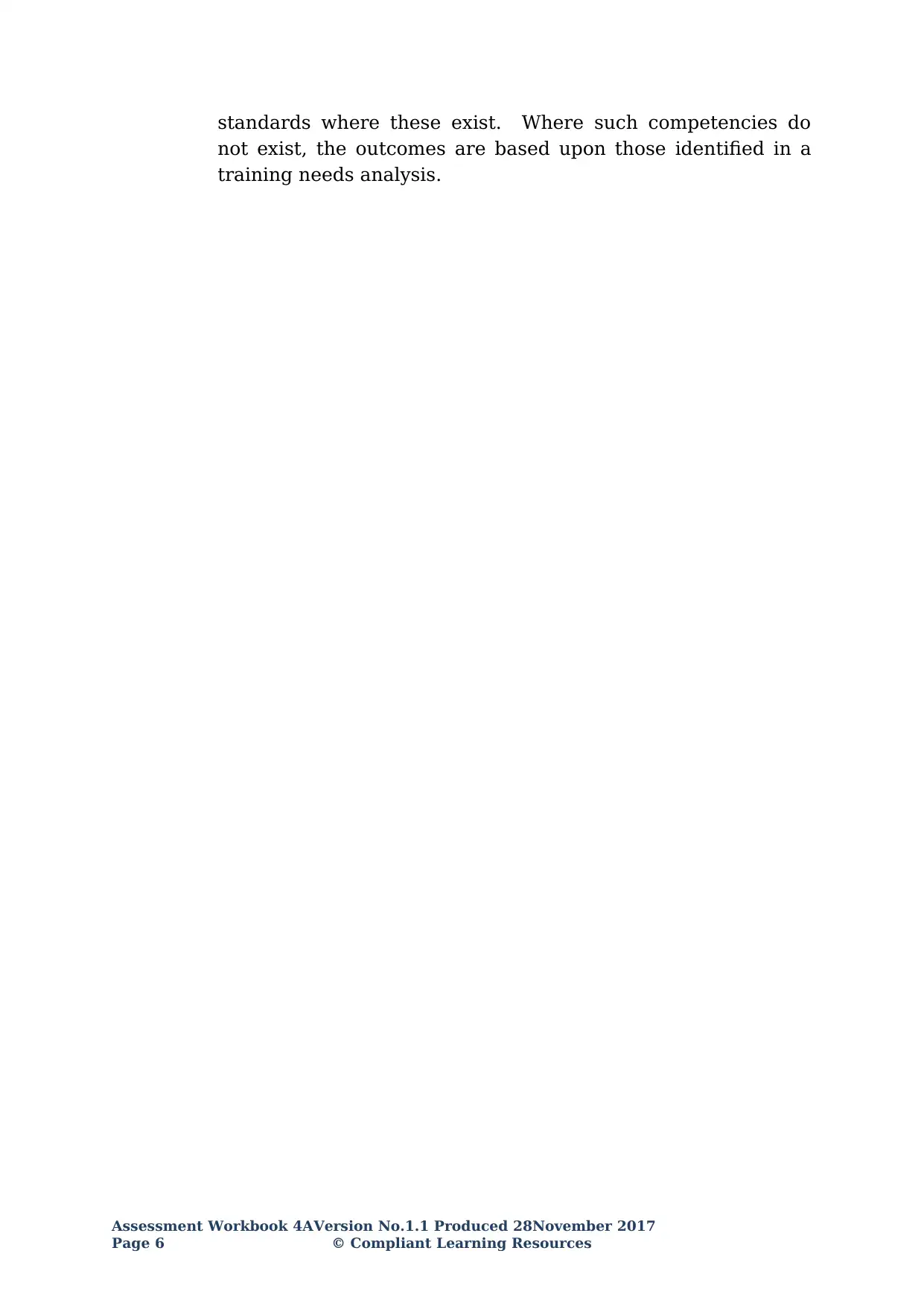
standards where these exist. Where such competencies do
not exist, the outcomes are based upon those identified in a
training needs analysis.
Assessment Workbook 4AVersion No.1.1 Produced 28November 2017
Page 6 © Compliant Learning Resources
not exist, the outcomes are based upon those identified in a
training needs analysis.
Assessment Workbook 4AVersion No.1.1 Produced 28November 2017
Page 6 © Compliant Learning Resources
⊘ This is a preview!⊘
Do you want full access?
Subscribe today to unlock all pages.

Trusted by 1+ million students worldwide
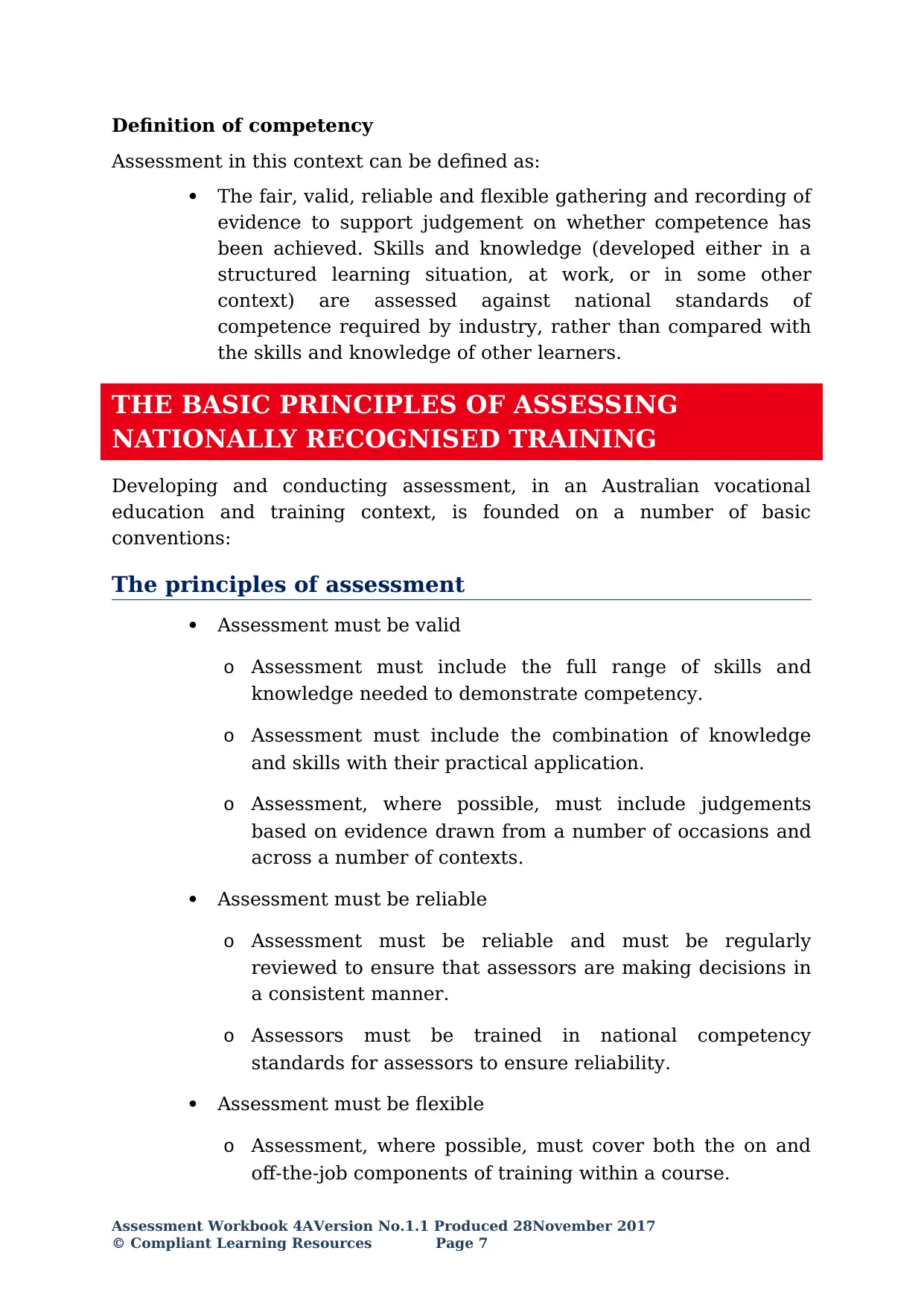
Definition of competency
Assessment in this context can be defined as:
The fair, valid, reliable and flexible gathering and recording of
evidence to support judgement on whether competence has
been achieved. Skills and knowledge (developed either in a
structured learning situation, at work, or in some other
context) are assessed against national standards of
competence required by industry, rather than compared with
the skills and knowledge of other learners.
THE BASIC PRINCIPLES OF ASSESSING
NATIONALLY RECOGNISED TRAINING
Developing and conducting assessment, in an Australian vocational
education and training context, is founded on a number of basic
conventions:
The principles of assessment
Assessment must be valid
o Assessment must include the full range of skills and
knowledge needed to demonstrate competency.
o Assessment must include the combination of knowledge
and skills with their practical application.
o Assessment, where possible, must include judgements
based on evidence drawn from a number of occasions and
across a number of contexts.
Assessment must be reliable
o Assessment must be reliable and must be regularly
reviewed to ensure that assessors are making decisions in
a consistent manner.
o Assessors must be trained in national competency
standards for assessors to ensure reliability.
Assessment must be flexible
o Assessment, where possible, must cover both the on and
off-the-job components of training within a course.
Assessment Workbook 4AVersion No.1.1 Produced 28November 2017
© Compliant Learning Resources Page 7
Assessment in this context can be defined as:
The fair, valid, reliable and flexible gathering and recording of
evidence to support judgement on whether competence has
been achieved. Skills and knowledge (developed either in a
structured learning situation, at work, or in some other
context) are assessed against national standards of
competence required by industry, rather than compared with
the skills and knowledge of other learners.
THE BASIC PRINCIPLES OF ASSESSING
NATIONALLY RECOGNISED TRAINING
Developing and conducting assessment, in an Australian vocational
education and training context, is founded on a number of basic
conventions:
The principles of assessment
Assessment must be valid
o Assessment must include the full range of skills and
knowledge needed to demonstrate competency.
o Assessment must include the combination of knowledge
and skills with their practical application.
o Assessment, where possible, must include judgements
based on evidence drawn from a number of occasions and
across a number of contexts.
Assessment must be reliable
o Assessment must be reliable and must be regularly
reviewed to ensure that assessors are making decisions in
a consistent manner.
o Assessors must be trained in national competency
standards for assessors to ensure reliability.
Assessment must be flexible
o Assessment, where possible, must cover both the on and
off-the-job components of training within a course.
Assessment Workbook 4AVersion No.1.1 Produced 28November 2017
© Compliant Learning Resources Page 7
Paraphrase This Document
Need a fresh take? Get an instant paraphrase of this document with our AI Paraphraser
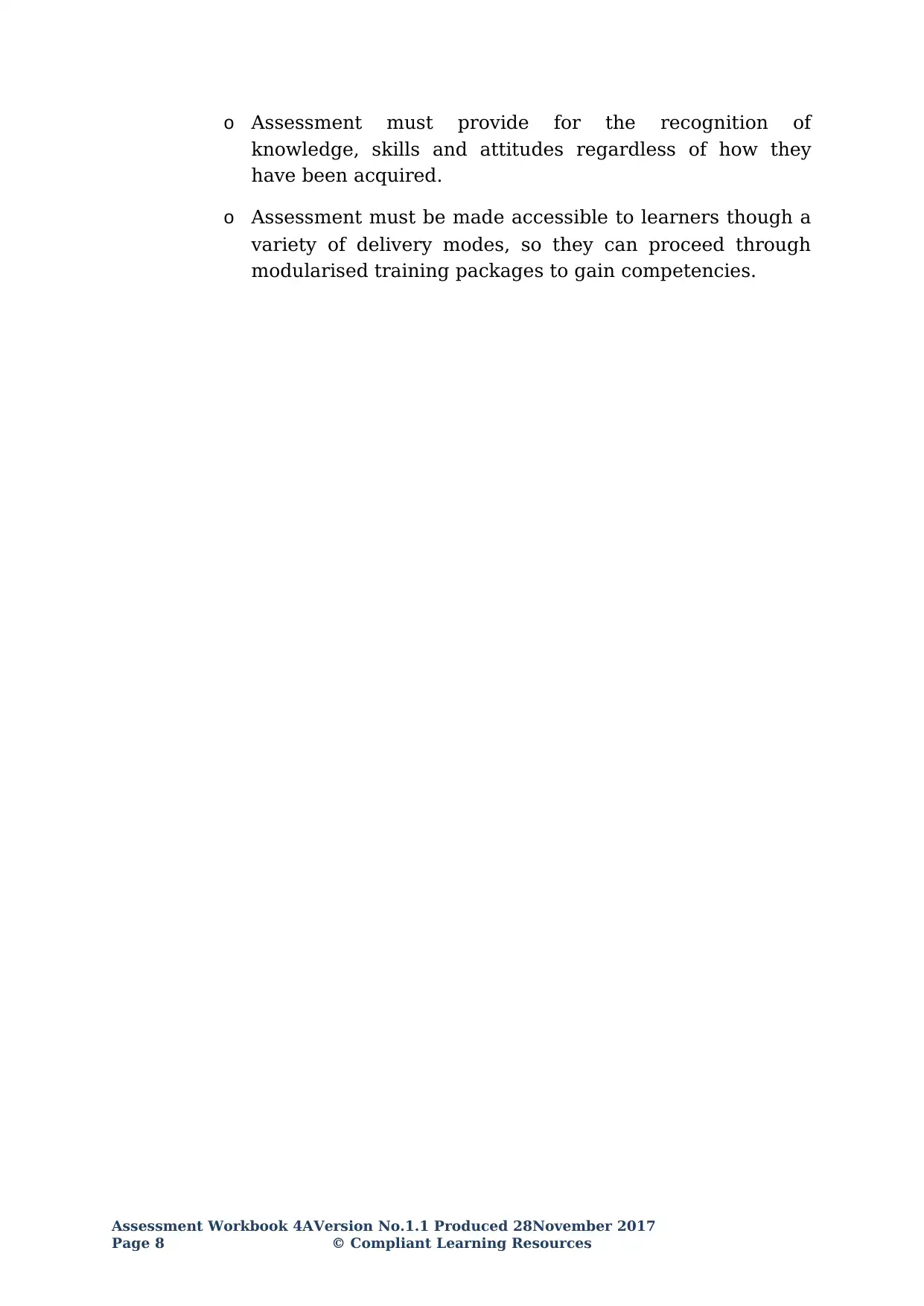
o Assessment must provide for the recognition of
knowledge, skills and attitudes regardless of how they
have been acquired.
o Assessment must be made accessible to learners though a
variety of delivery modes, so they can proceed through
modularised training packages to gain competencies.
Assessment Workbook 4AVersion No.1.1 Produced 28November 2017
Page 8 © Compliant Learning Resources
knowledge, skills and attitudes regardless of how they
have been acquired.
o Assessment must be made accessible to learners though a
variety of delivery modes, so they can proceed through
modularised training packages to gain competencies.
Assessment Workbook 4AVersion No.1.1 Produced 28November 2017
Page 8 © Compliant Learning Resources
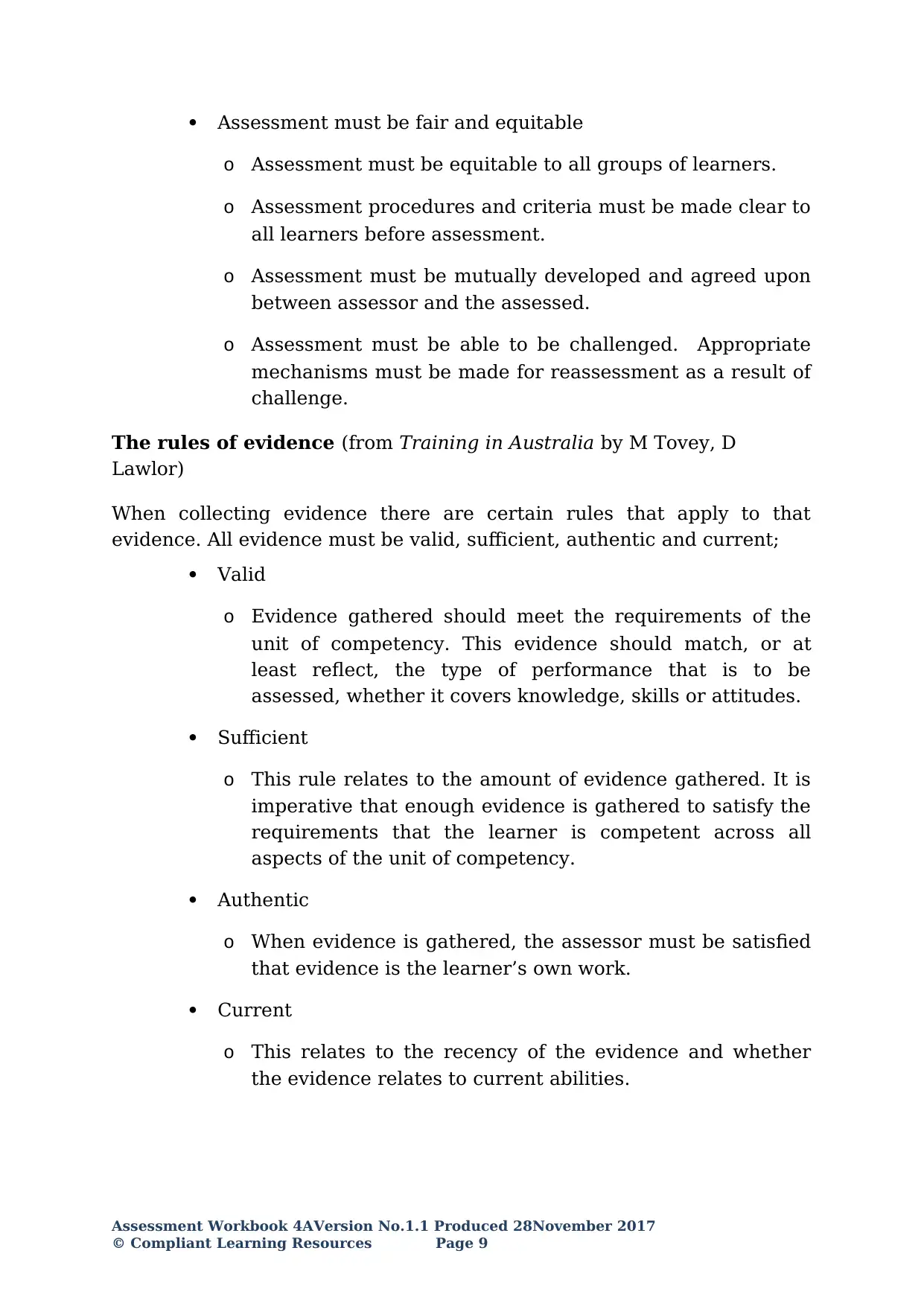
Assessment must be fair and equitable
o Assessment must be equitable to all groups of learners.
o Assessment procedures and criteria must be made clear to
all learners before assessment.
o Assessment must be mutually developed and agreed upon
between assessor and the assessed.
o Assessment must be able to be challenged. Appropriate
mechanisms must be made for reassessment as a result of
challenge.
The rules of evidence (from Training in Australia by M Tovey, D
Lawlor)
When collecting evidence there are certain rules that apply to that
evidence. All evidence must be valid, sufficient, authentic and current;
Valid
o Evidence gathered should meet the requirements of the
unit of competency. This evidence should match, or at
least reflect, the type of performance that is to be
assessed, whether it covers knowledge, skills or attitudes.
Sufficient
o This rule relates to the amount of evidence gathered. It is
imperative that enough evidence is gathered to satisfy the
requirements that the learner is competent across all
aspects of the unit of competency.
Authentic
o When evidence is gathered, the assessor must be satisfied
that evidence is the learner’s own work.
Current
o This relates to the recency of the evidence and whether
the evidence relates to current abilities.
Assessment Workbook 4AVersion No.1.1 Produced 28November 2017
© Compliant Learning Resources Page 9
o Assessment must be equitable to all groups of learners.
o Assessment procedures and criteria must be made clear to
all learners before assessment.
o Assessment must be mutually developed and agreed upon
between assessor and the assessed.
o Assessment must be able to be challenged. Appropriate
mechanisms must be made for reassessment as a result of
challenge.
The rules of evidence (from Training in Australia by M Tovey, D
Lawlor)
When collecting evidence there are certain rules that apply to that
evidence. All evidence must be valid, sufficient, authentic and current;
Valid
o Evidence gathered should meet the requirements of the
unit of competency. This evidence should match, or at
least reflect, the type of performance that is to be
assessed, whether it covers knowledge, skills or attitudes.
Sufficient
o This rule relates to the amount of evidence gathered. It is
imperative that enough evidence is gathered to satisfy the
requirements that the learner is competent across all
aspects of the unit of competency.
Authentic
o When evidence is gathered, the assessor must be satisfied
that evidence is the learner’s own work.
Current
o This relates to the recency of the evidence and whether
the evidence relates to current abilities.
Assessment Workbook 4AVersion No.1.1 Produced 28November 2017
© Compliant Learning Resources Page 9
⊘ This is a preview!⊘
Do you want full access?
Subscribe today to unlock all pages.

Trusted by 1+ million students worldwide
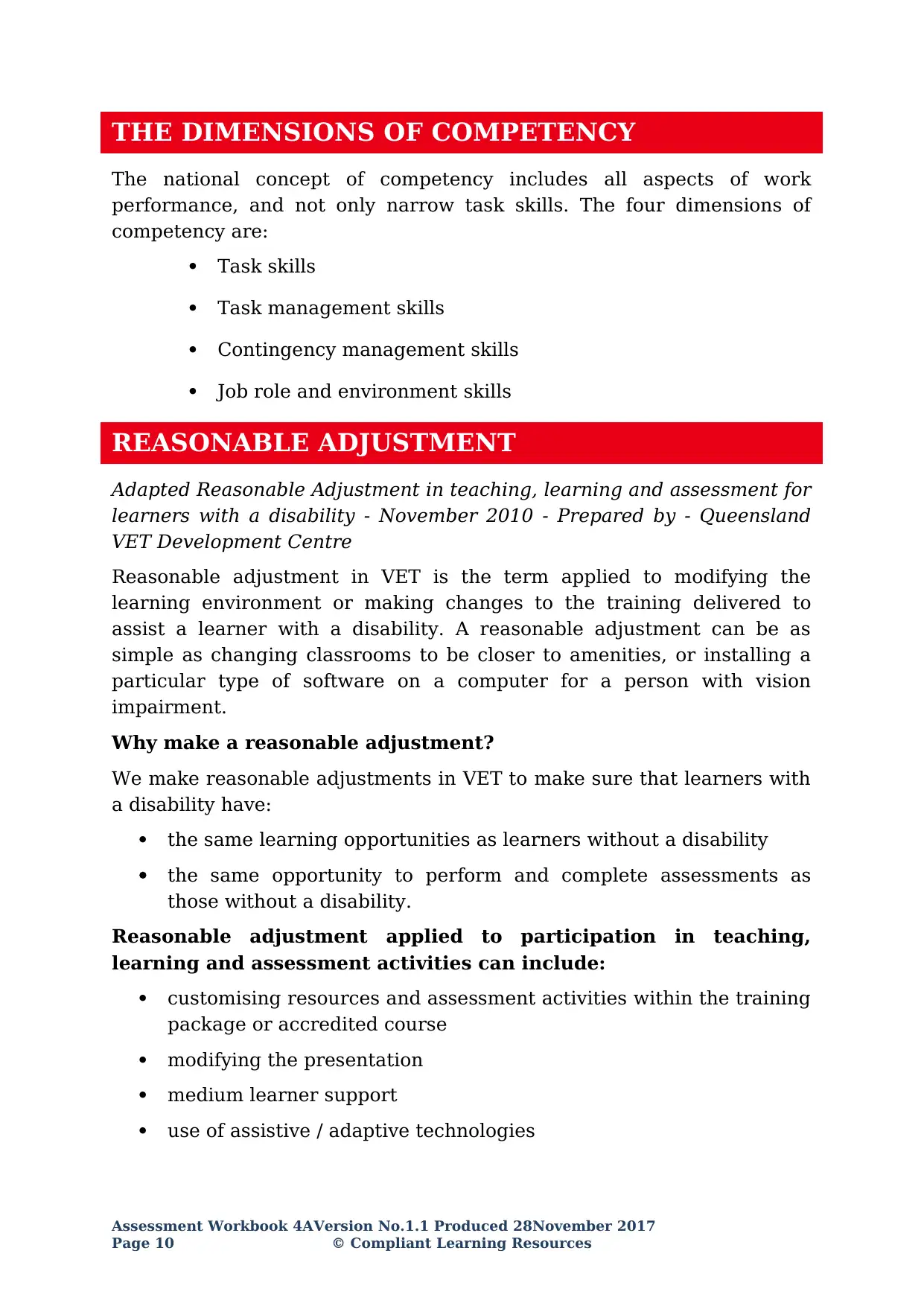
THE DIMENSIONS OF COMPETENCY
The national concept of competency includes all aspects of work
performance, and not only narrow task skills. The four dimensions of
competency are:
Task skills
Task management skills
Contingency management skills
Job role and environment skills
REASONABLE ADJUSTMENT
Adapted Reasonable Adjustment in teaching, learning and assessment for
learners with a disability - November 2010 - Prepared by - Queensland
VET Development Centre
Reasonable adjustment in VET is the term applied to modifying the
learning environment or making changes to the training delivered to
assist a learner with a disability. A reasonable adjustment can be as
simple as changing classrooms to be closer to amenities, or installing a
particular type of software on a computer for a person with vision
impairment.
Why make a reasonable adjustment?
We make reasonable adjustments in VET to make sure that learners with
a disability have:
the same learning opportunities as learners without a disability
the same opportunity to perform and complete assessments as
those without a disability.
Reasonable adjustment applied to participation in teaching,
learning and assessment activities can include:
customising resources and assessment activities within the training
package or accredited course
modifying the presentation
medium learner support
use of assistive / adaptive technologies
Assessment Workbook 4AVersion No.1.1 Produced 28November 2017
Page 10 © Compliant Learning Resources
The national concept of competency includes all aspects of work
performance, and not only narrow task skills. The four dimensions of
competency are:
Task skills
Task management skills
Contingency management skills
Job role and environment skills
REASONABLE ADJUSTMENT
Adapted Reasonable Adjustment in teaching, learning and assessment for
learners with a disability - November 2010 - Prepared by - Queensland
VET Development Centre
Reasonable adjustment in VET is the term applied to modifying the
learning environment or making changes to the training delivered to
assist a learner with a disability. A reasonable adjustment can be as
simple as changing classrooms to be closer to amenities, or installing a
particular type of software on a computer for a person with vision
impairment.
Why make a reasonable adjustment?
We make reasonable adjustments in VET to make sure that learners with
a disability have:
the same learning opportunities as learners without a disability
the same opportunity to perform and complete assessments as
those without a disability.
Reasonable adjustment applied to participation in teaching,
learning and assessment activities can include:
customising resources and assessment activities within the training
package or accredited course
modifying the presentation
medium learner support
use of assistive / adaptive technologies
Assessment Workbook 4AVersion No.1.1 Produced 28November 2017
Page 10 © Compliant Learning Resources
Paraphrase This Document
Need a fresh take? Get an instant paraphrase of this document with our AI Paraphraser
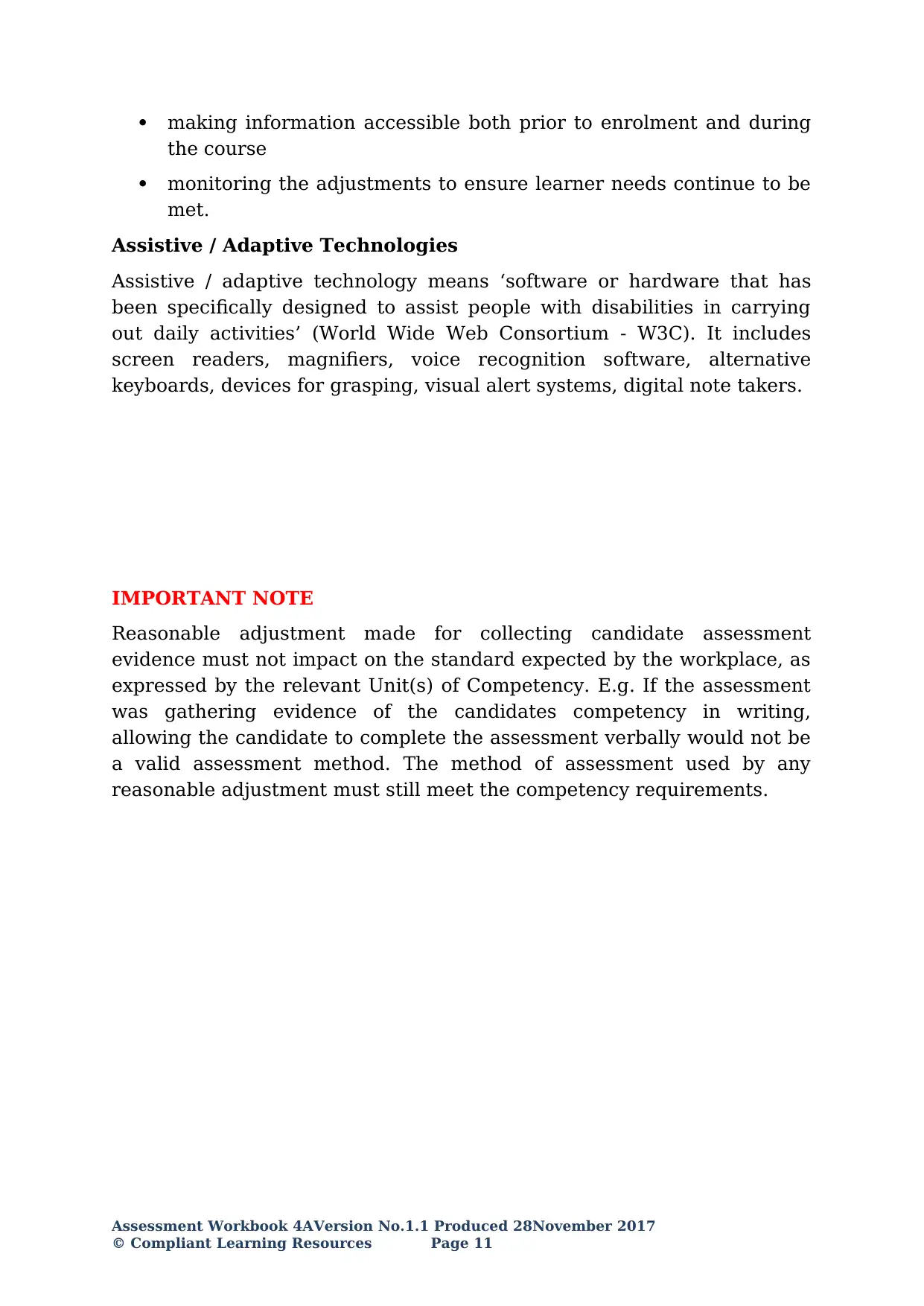
making information accessible both prior to enrolment and during
the course
monitoring the adjustments to ensure learner needs continue to be
met.
Assistive / Adaptive Technologies
Assistive / adaptive technology means ‘software or hardware that has
been specifically designed to assist people with disabilities in carrying
out daily activities’ (World Wide Web Consortium - W3C). It includes
screen readers, magnifiers, voice recognition software, alternative
keyboards, devices for grasping, visual alert systems, digital note takers.
IMPORTANT NOTE
Reasonable adjustment made for collecting candidate assessment
evidence must not impact on the standard expected by the workplace, as
expressed by the relevant Unit(s) of Competency. E.g. If the assessment
was gathering evidence of the candidates competency in writing,
allowing the candidate to complete the assessment verbally would not be
a valid assessment method. The method of assessment used by any
reasonable adjustment must still meet the competency requirements.
Assessment Workbook 4AVersion No.1.1 Produced 28November 2017
© Compliant Learning Resources Page 11
the course
monitoring the adjustments to ensure learner needs continue to be
met.
Assistive / Adaptive Technologies
Assistive / adaptive technology means ‘software or hardware that has
been specifically designed to assist people with disabilities in carrying
out daily activities’ (World Wide Web Consortium - W3C). It includes
screen readers, magnifiers, voice recognition software, alternative
keyboards, devices for grasping, visual alert systems, digital note takers.
IMPORTANT NOTE
Reasonable adjustment made for collecting candidate assessment
evidence must not impact on the standard expected by the workplace, as
expressed by the relevant Unit(s) of Competency. E.g. If the assessment
was gathering evidence of the candidates competency in writing,
allowing the candidate to complete the assessment verbally would not be
a valid assessment method. The method of assessment used by any
reasonable adjustment must still meet the competency requirements.
Assessment Workbook 4AVersion No.1.1 Produced 28November 2017
© Compliant Learning Resources Page 11
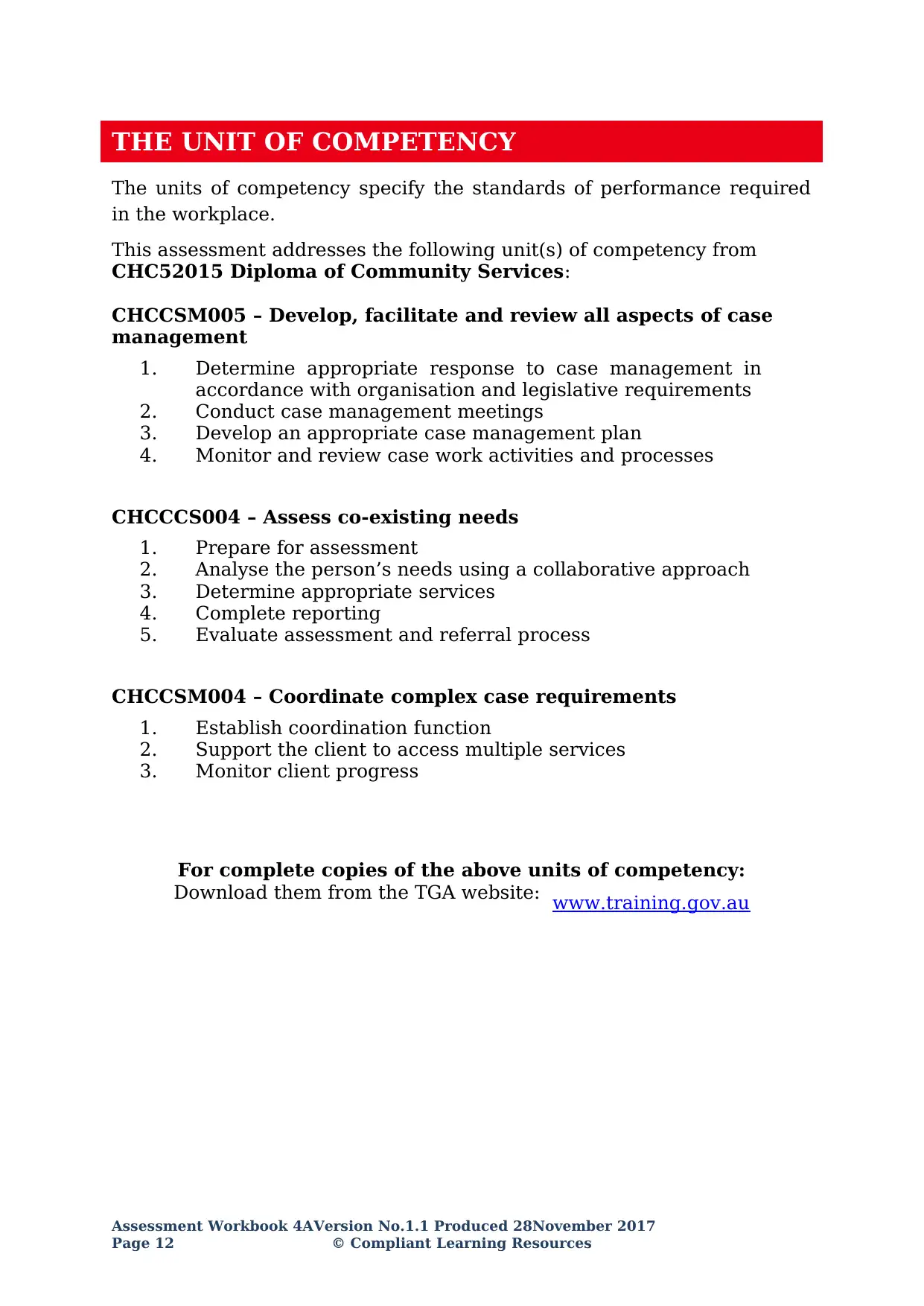
THE UNIT OF COMPETENCY
The units of competency specify the standards of performance required
in the workplace.
This assessment addresses the following unit(s) of competency from
CHC52015 Diploma of Community Services:
CHCCSM005 – Develop, facilitate and review all aspects of case
management
1. Determine appropriate response to case management in
accordance with organisation and legislative requirements
2. Conduct case management meetings
3. Develop an appropriate case management plan
4. Monitor and review case work activities and processes
CHCCCS004 – Assess co-existing needs
1. Prepare for assessment
2. Analyse the person’s needs using a collaborative approach
3. Determine appropriate services
4. Complete reporting
5. Evaluate assessment and referral process
CHCCSM004 – Coordinate complex case requirements
1. Establish coordination function
2. Support the client to access multiple services
3. Monitor client progress
For complete copies of the above units of competency:
Download them from the TGA website: www.training.gov.au
Assessment Workbook 4AVersion No.1.1 Produced 28November 2017
Page 12 © Compliant Learning Resources
The units of competency specify the standards of performance required
in the workplace.
This assessment addresses the following unit(s) of competency from
CHC52015 Diploma of Community Services:
CHCCSM005 – Develop, facilitate and review all aspects of case
management
1. Determine appropriate response to case management in
accordance with organisation and legislative requirements
2. Conduct case management meetings
3. Develop an appropriate case management plan
4. Monitor and review case work activities and processes
CHCCCS004 – Assess co-existing needs
1. Prepare for assessment
2. Analyse the person’s needs using a collaborative approach
3. Determine appropriate services
4. Complete reporting
5. Evaluate assessment and referral process
CHCCSM004 – Coordinate complex case requirements
1. Establish coordination function
2. Support the client to access multiple services
3. Monitor client progress
For complete copies of the above units of competency:
Download them from the TGA website: www.training.gov.au
Assessment Workbook 4AVersion No.1.1 Produced 28November 2017
Page 12 © Compliant Learning Resources
⊘ This is a preview!⊘
Do you want full access?
Subscribe today to unlock all pages.

Trusted by 1+ million students worldwide
1 out of 63
Related Documents
Your All-in-One AI-Powered Toolkit for Academic Success.
+13062052269
info@desklib.com
Available 24*7 on WhatsApp / Email
![[object Object]](/_next/static/media/star-bottom.7253800d.svg)
Unlock your academic potential
Copyright © 2020–2025 A2Z Services. All Rights Reserved. Developed and managed by ZUCOL.





